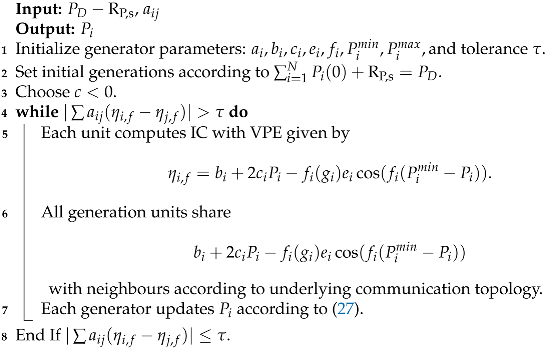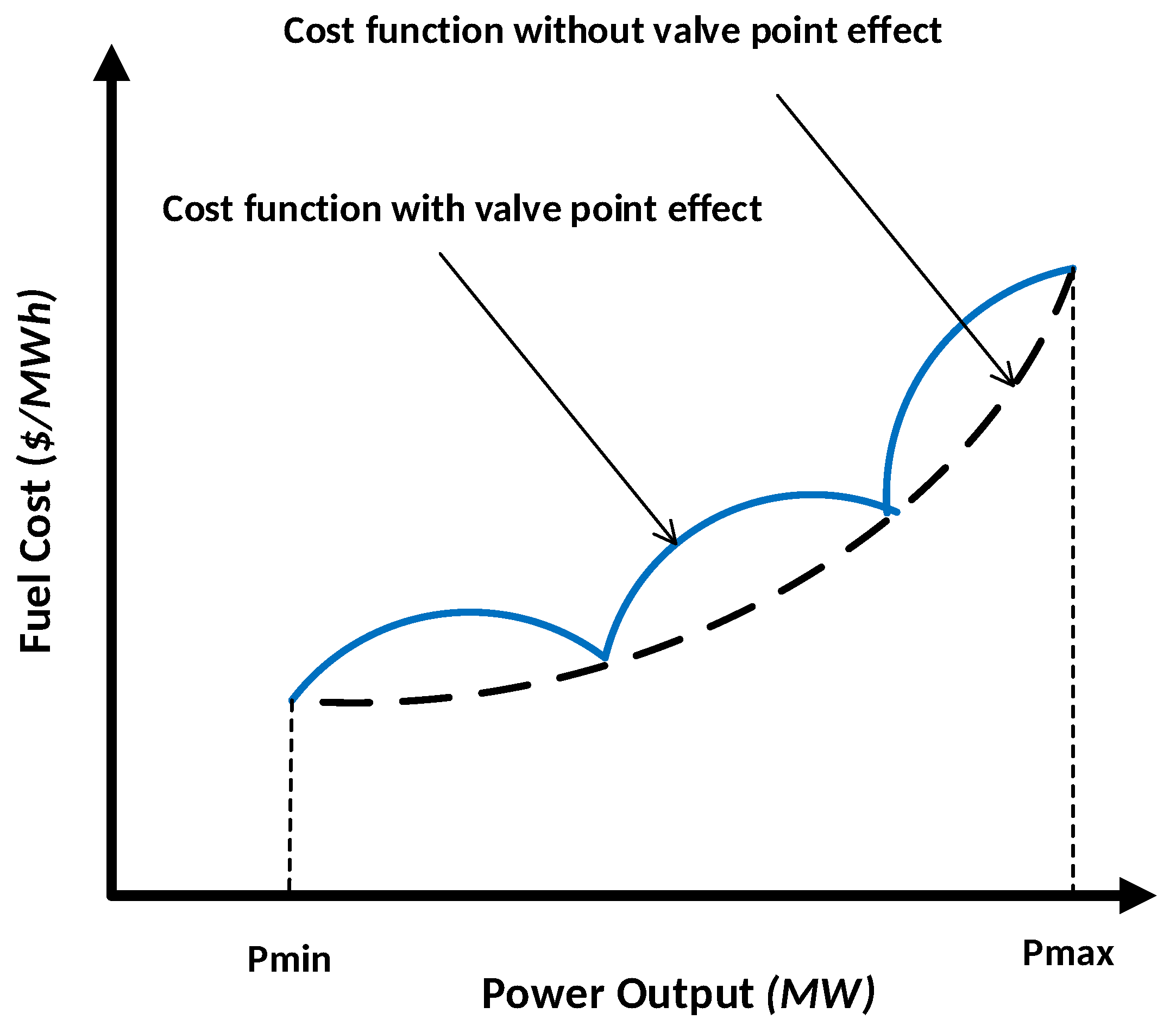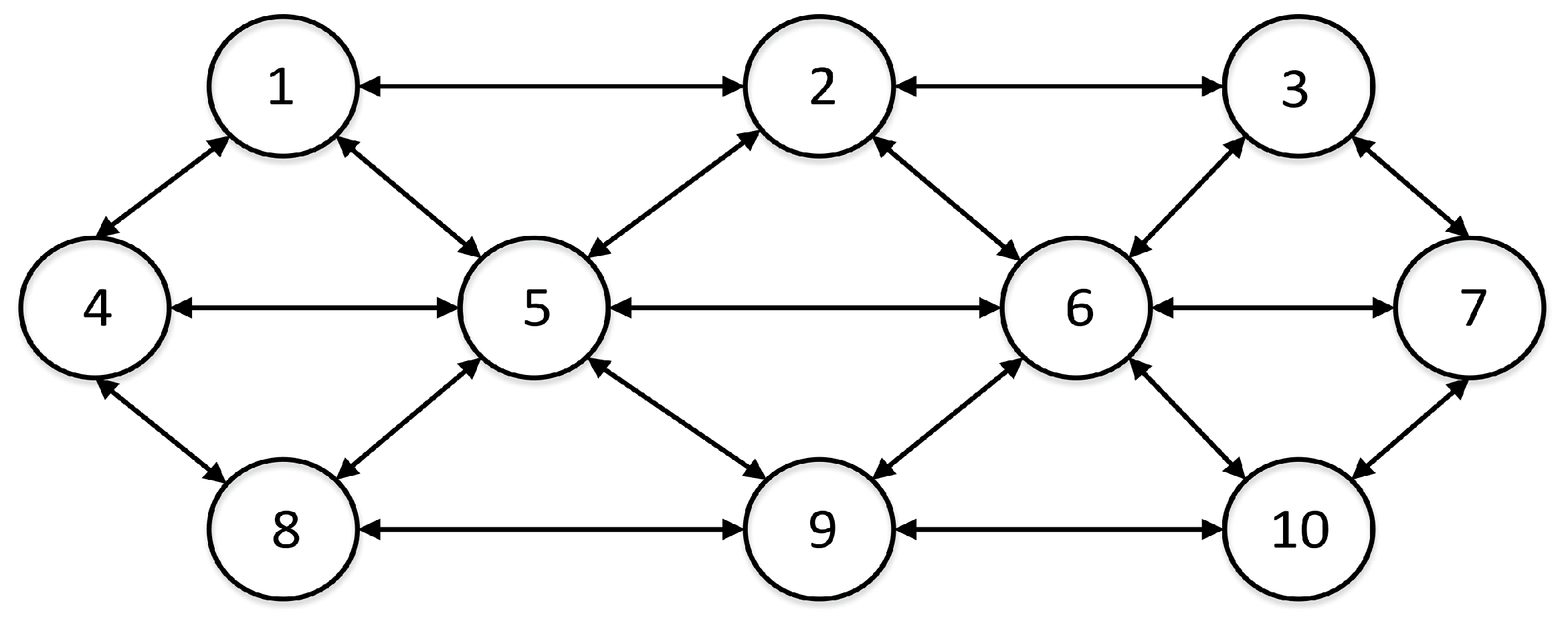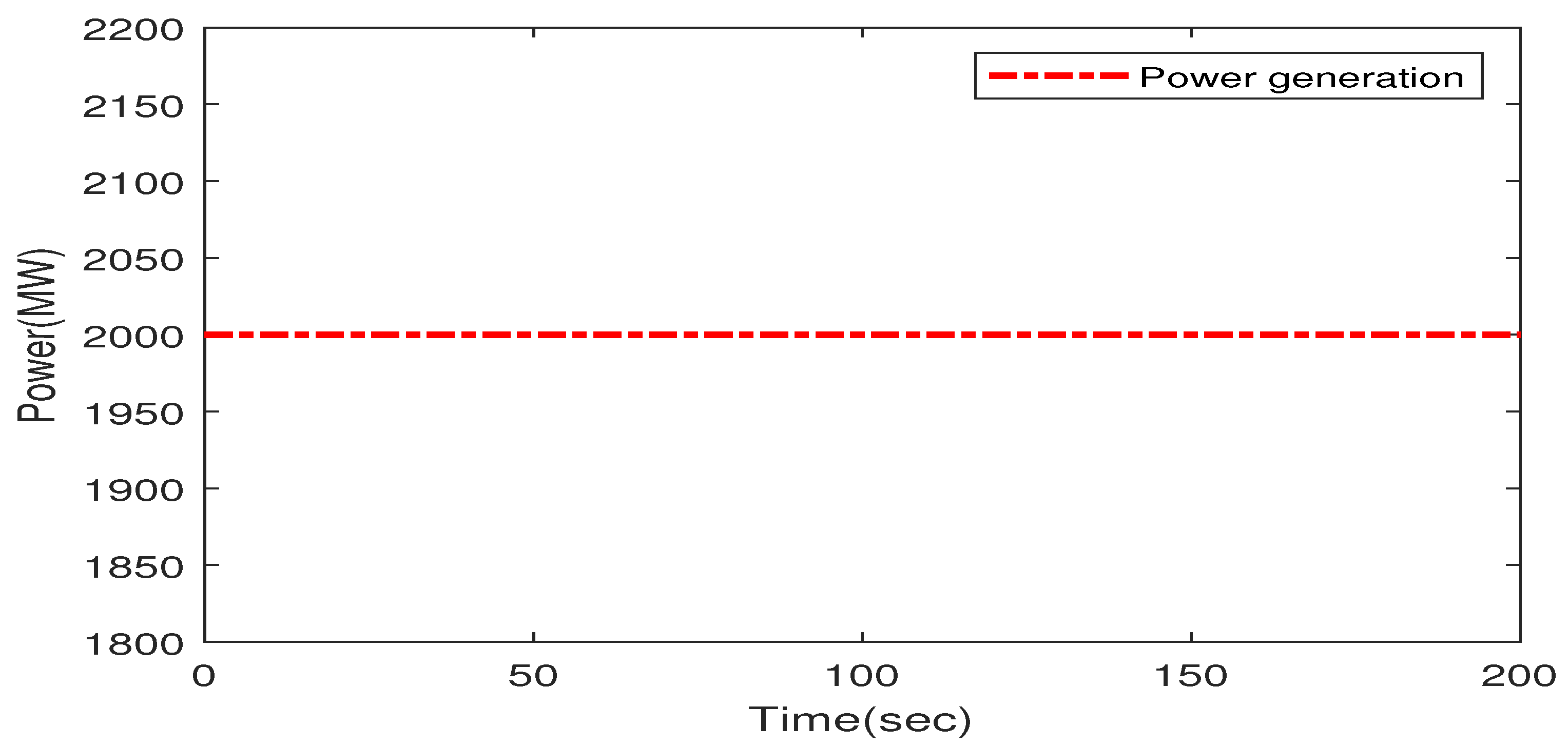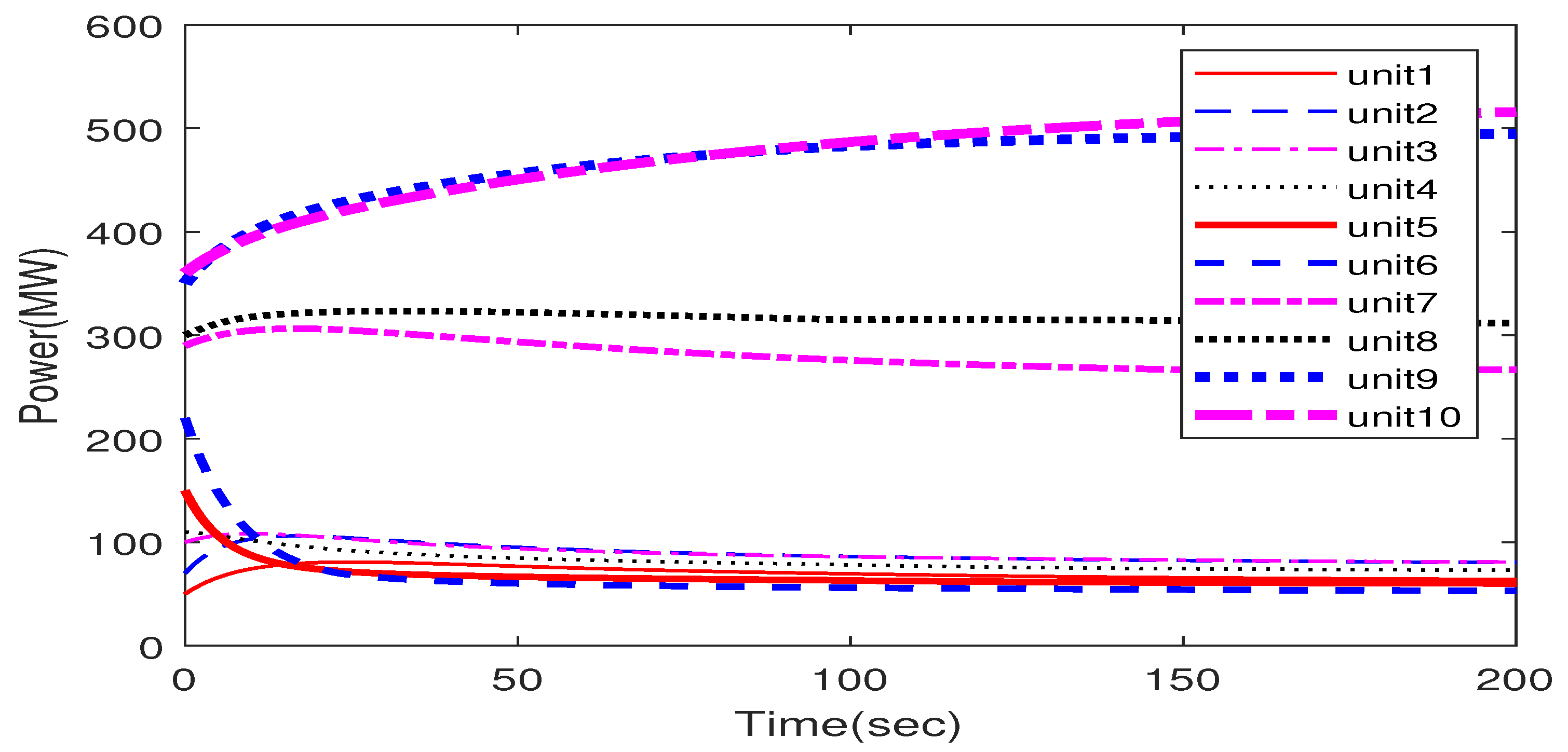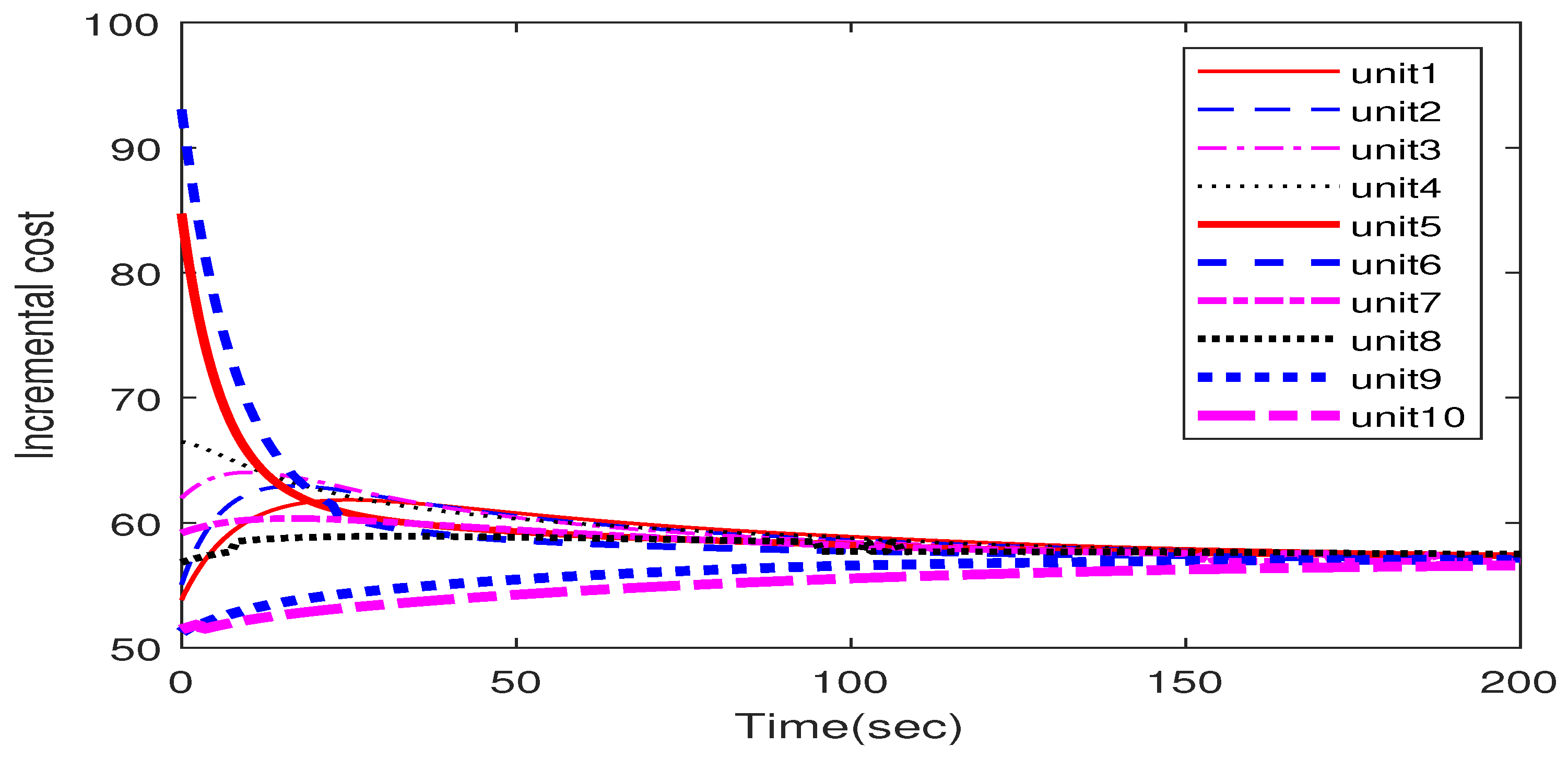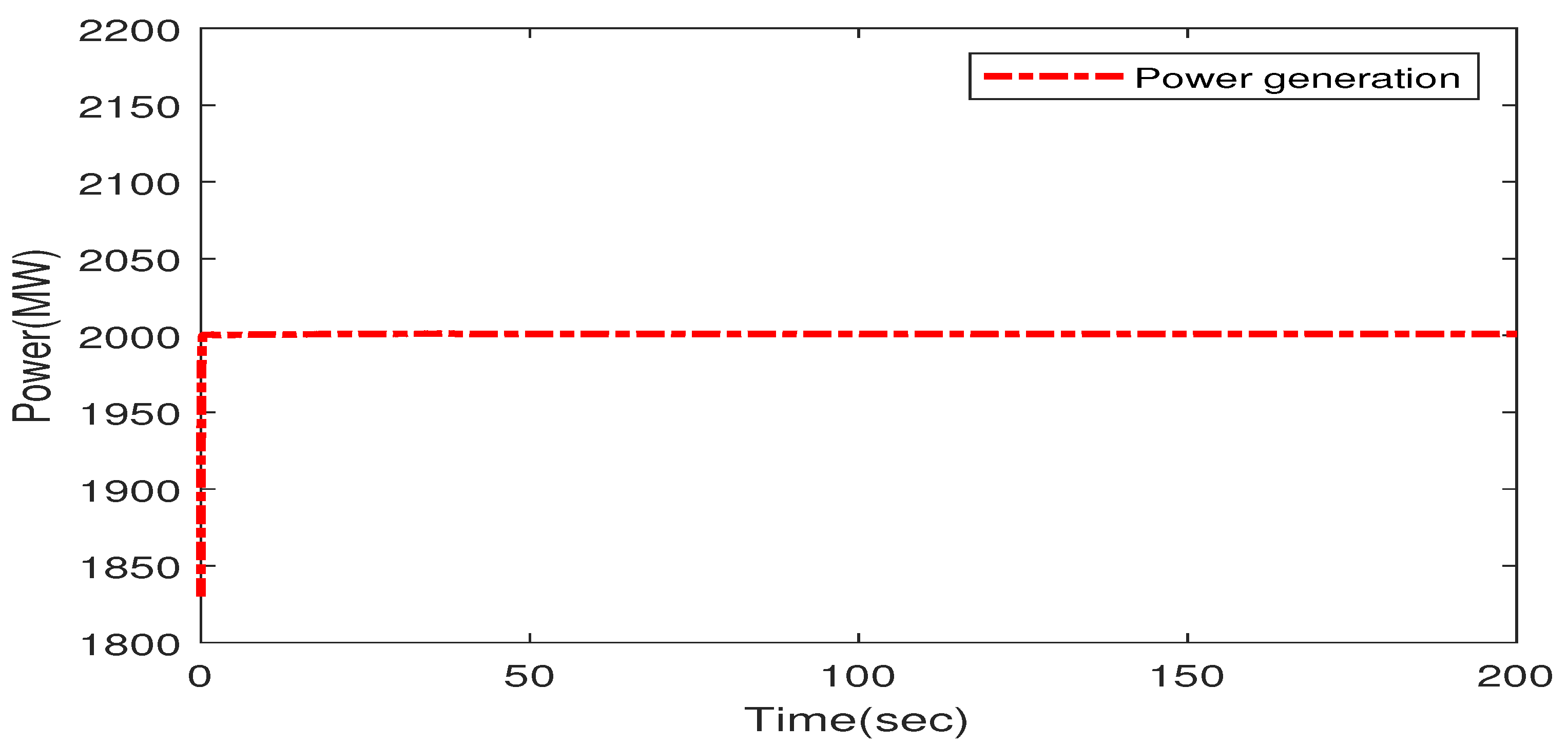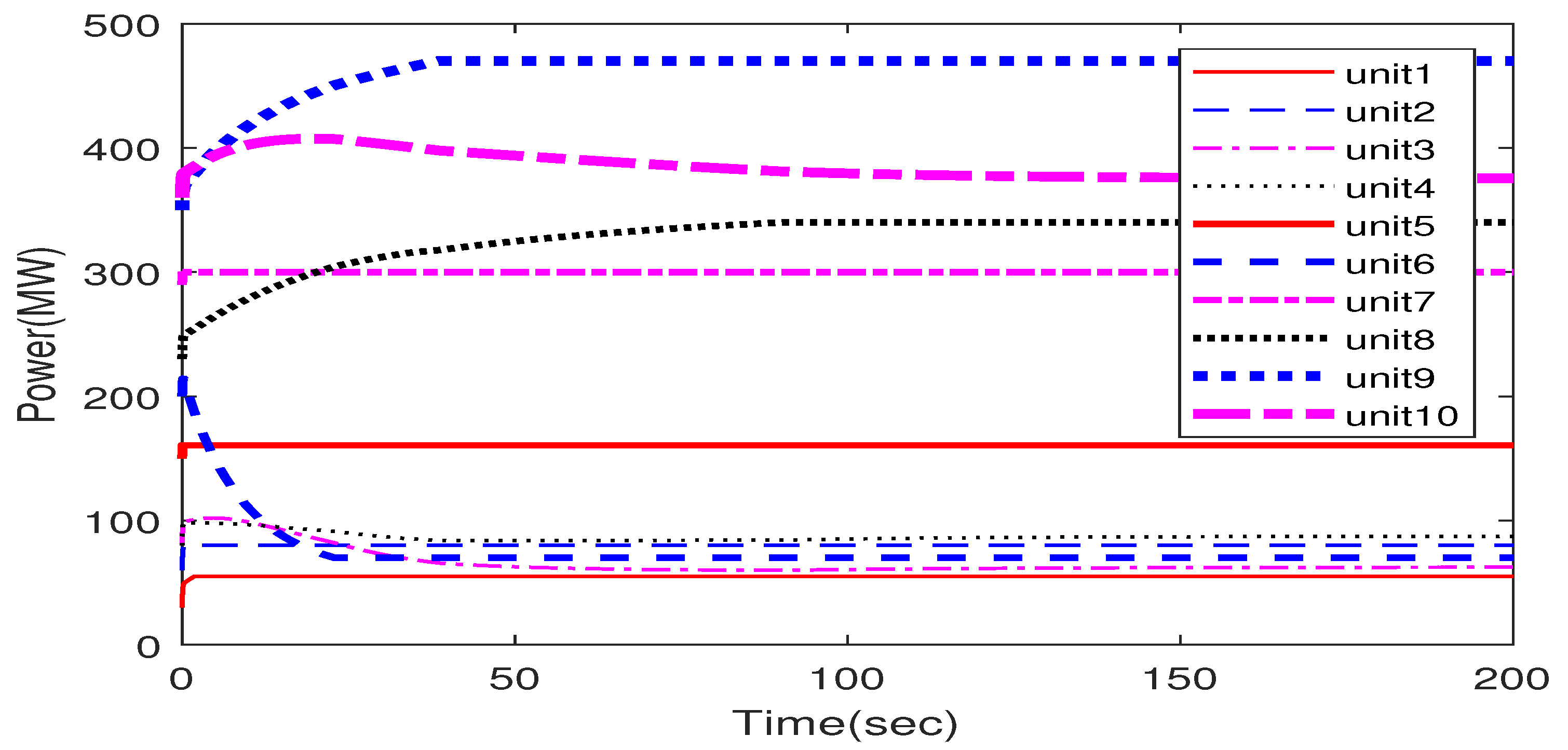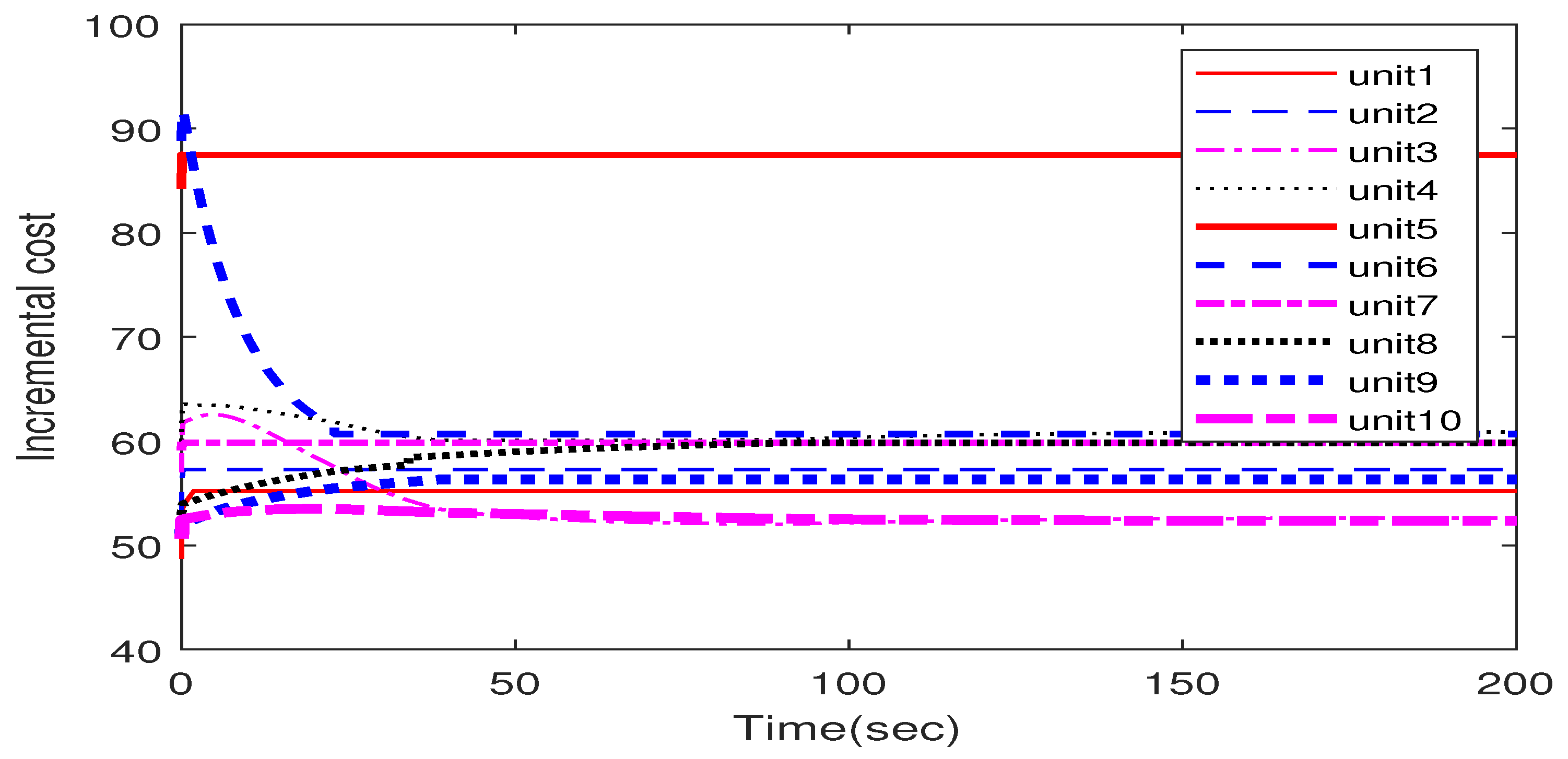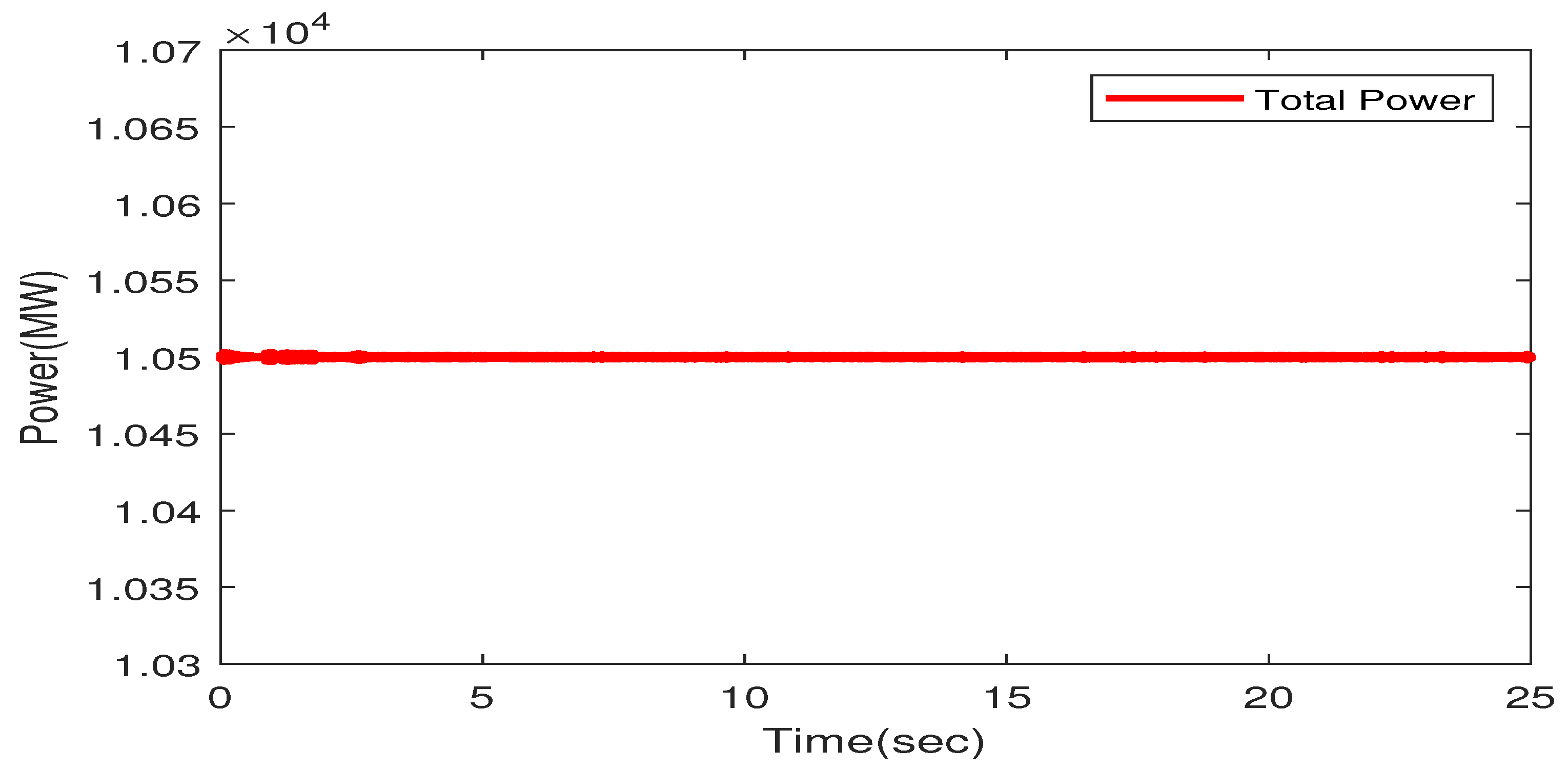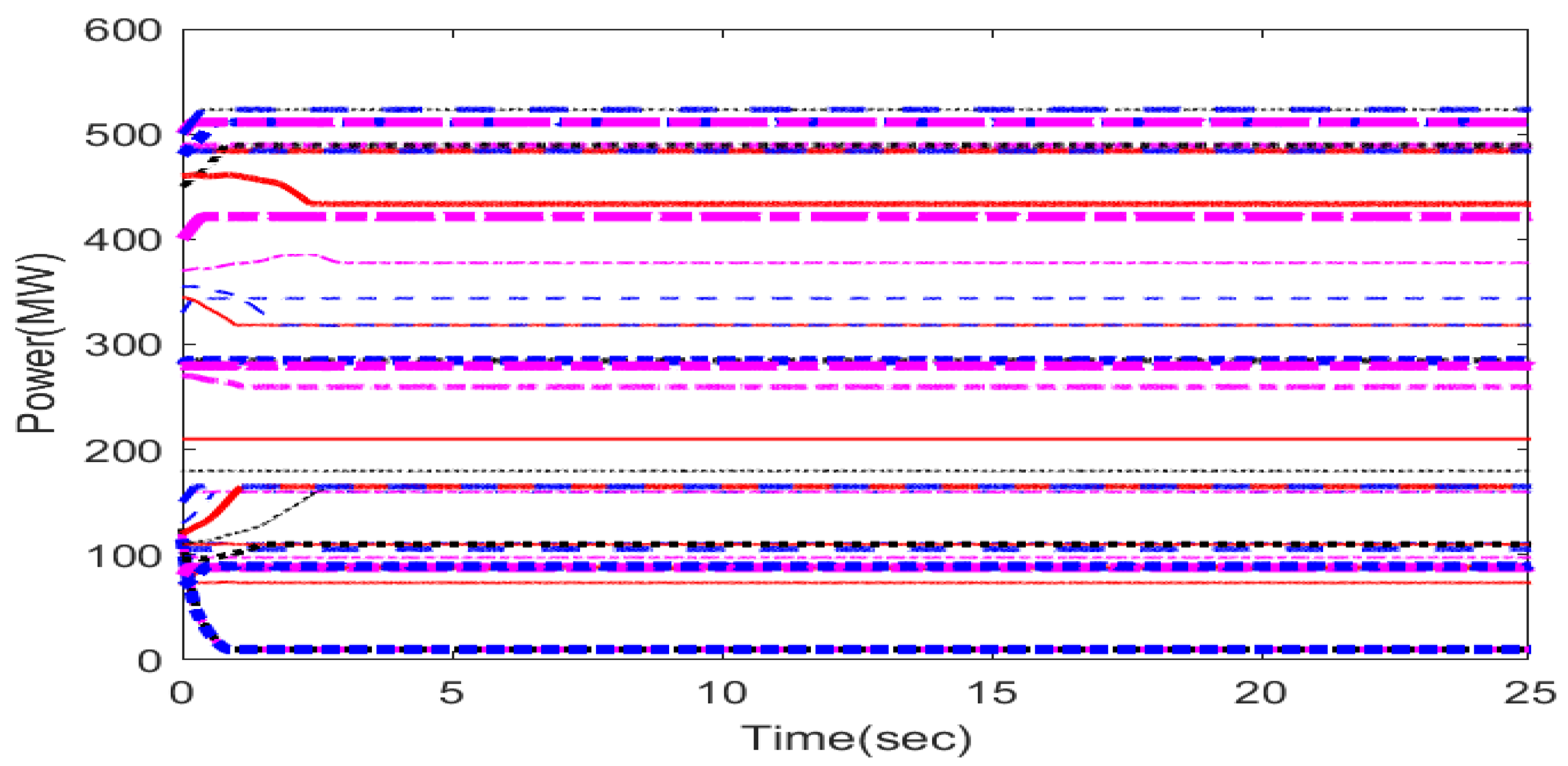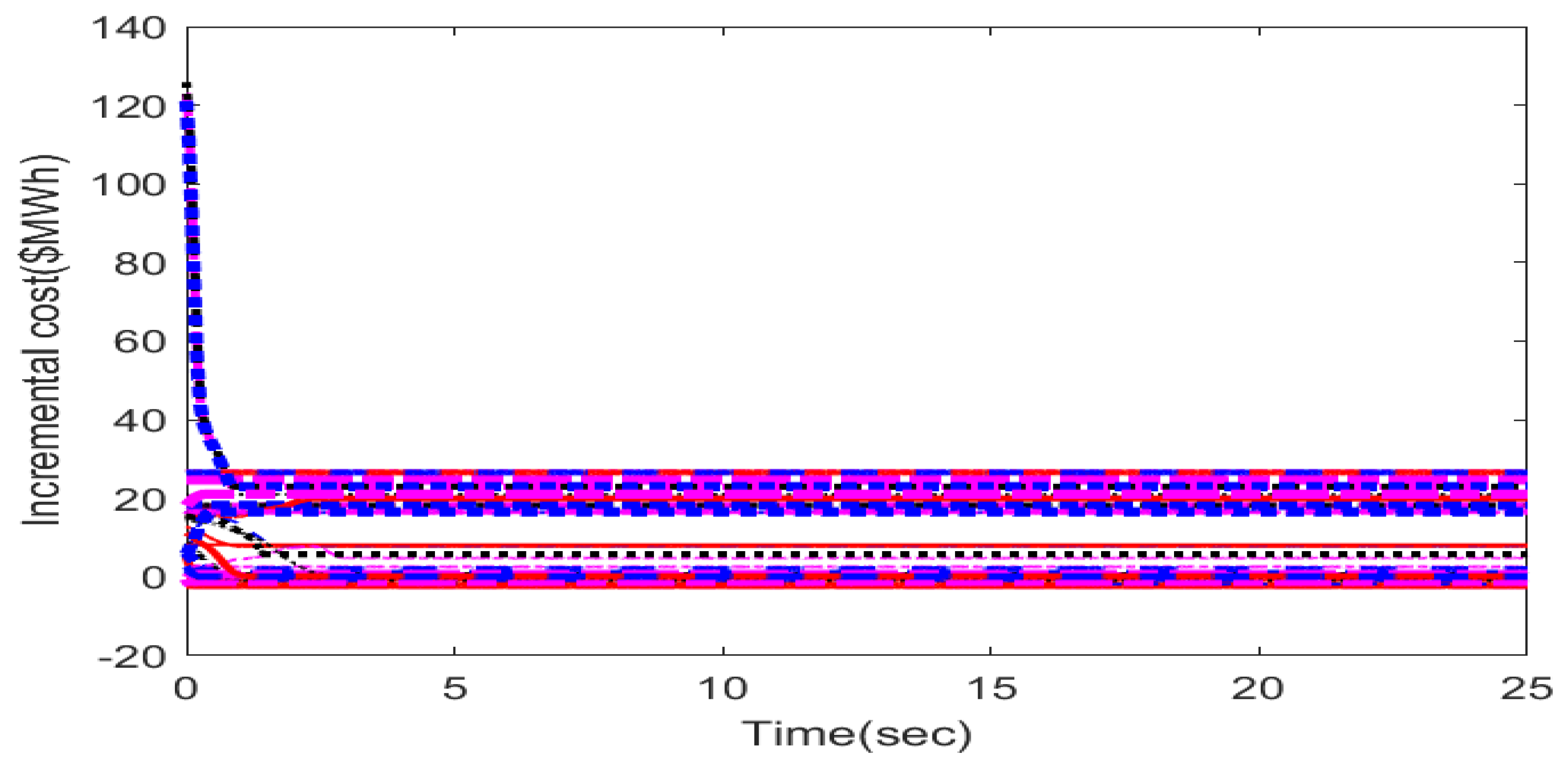1. Introduction
In recent years, great attention has been given to the study and development of optimization techniques; see, for instance [
1,
2,
3,
4,
5]. One of the fundamental optimization problems in power systems is deciding the output power of generation facilities that minimizes the total generation cost, which is commonly referred to as the economic dispatch problem (EDP). The EDP has been widely investigated since the advent of computers, and efforts have been focused on developing centralized optimization algorithms [
6,
7]. Particle swarm optimization (PSO) is the most popular among other metaheuristic techniques, despite the fact that it may not converge to an optimal solution in the case of the non-convex power system optimization problem [
8]. Inspired by PSO, economic dispatch algorithms were investigated by considering generation constraints [
9] and wind power uncertainty [
10].
The consideration of the valve-point effect (VPE), resulting from the sequential opening of control valves in thermal power plants, makes the cost function highly nonlinear. Due to the VPE, some ripples float over the cost function, which may be modeled as rectified sine waves. Different techniques are well-established in the literature for solving complex EDP considering the VPE. A genetic algorithm with a multi-parent crossover solution for the EDP with the VPE was presented in [
11]. The coalescence of incremental rates and bee colony optimization methods were used in [
12]. The authors in [
13] used the iterative piece-wise linear function approximation and mixed integer programming to find an optimal solution, and the obtained solution was then improved using the nonlinear programming models. In [
14] (see also [
15]), a multi-population-based differential evolution algorithm was applied to optimize the cost function with the VPE. All of these approaches for solving the EDP with the VPE are centralized and require a central controller to receive information from available nodes.
Emerging technologies of renewable energy resources (RESs), such as solar energy, wind energy, and hydro-power, have influenced researchers to devise methods to solve the EDP, considering integrated power plants. Authors in [
16] have exploited PSO, Newton–Raphson, and binary integer programming methods for finding a combined optimized solution for solar integrated power systems. The work of [
17] considered a modified genetic algorithm for the consideration of thermal power cost optimization along with wind–solar constraints for a reduction in toxic emissions. The concept of a multi-generation system based on photovoltaic cells along with a battery system for the cost of energy optimization was revealed in [
18]. To attain a low-carbon economic dispatch, through the consideration of bio-gas, wind, and solar sources, the work of [
19] considered the stochastic optimization approach. The methods of [
20,
21] accounted for low-carbon energy optimization under various constraints by considering uncertainties in solar irradiance and energy efficiency, respectively. The major common concern in the above-mentioned algorithms [
11,
12,
13,
14,
17,
18,
19,
20,
21] is that these methods apply a central dispatching facility, which gathers data of all generation nodes and gives a dispatch command to all nodes accordingly. The centralized approaches have several concerns, such as a single-point of failure (if the central node fails), system insecurity as the central processor can be vulnerable to cyber-attacks), and time-delays (due to the communication of all nodes with a central dispatch center). In addition, these centralized optimization methods have privacy of data issues in a competitive environment, increase the business of the main server due to requests from all generating nodes, and have computational issues due to a central facility. Owing to these shortcomings, efforts have been devoted in the recent era to investigate distributed techniques, as observed in [
22,
23,
24,
25,
26,
27,
28,
29].
Recently, the cooperative control of multiagent systems (MASs) has been widely investigated and the EDP has transformed into the consensus of MASs. Some recent works on applying consensus theory to resolve the EDP in a distributed manner were discussed in [
30,
31,
32,
33,
34,
35]. Authors in [
36] showed that the distributed EDP is solvable, and an optimal solution can be obtained if the incremental costs (ICs) of all generation facilities reach an agreement. In [
37], a fully distributed control strategy was designed using two-level control through an upper level for discovering the reference of optimal power generation and a lower level for reference tracking. The method in [
38] utilized stochastic programming along with robust and distributed optimization methods to minimize the overall cost of all generation units, including uncertain and intermittent renewable generations. The work in [
39] developed a distributed scheme via an alternating direction method of multipliers for resolving the EDP. To address communication delays, it was studied in [
40] that a discrete-time consensus approach should be adopted because information flows discretely through the underlying communication network. A distributed consensus strategy for EDP with communication delays was presented in [
41]. Adaptive consensus-based strategies for EDP under communication uncertainties were designed in [
42,
43]. Based on the literature review, a brief detail of different areas considered in the existing works is provided in
Table 1. Most of the attention in the above-mentioned literature is paid to minimizing a quadratic cost function, which is a smooth and convex function. An attempt to solve EDP-VPE using a distributed consensus approach was presented in [
44], where piece-wise linear approximation was used for each nonlinear region. Approximation results in a loss of information, and the consideration of multiple regions makes this approach highly conservative.
This paper deals with a distributed cooperative optimization (rather than the conventional central optimization) approach for the economic dispatch by considering thermal generators under the VPE and a solar energy system for attaining low-carbon footprints. A new algorithm for dispatching the powers economically by employing the beta distribution function for solar irradiance and by considering a smart-grid via cooperation and communication between generators through graph theory has been revealed. Here, a consensus-based distributed algorithm was designed to solve the EDP with a quadratic cost function and VPE, which takes the generator’s output power as the consensus update variable and local power mismatch as the feedback variable. It was shown that updating the generators’ output power in the consensus-based optimization protocol ultimately results in a consensus of the proposed modified ICs with the VPE under an initial supply–demand balance assumption according to RESs. The authors further improved the distributed algorithm to deal with the generation capacity constraint by adding a power limit compensation factor and by omitting the initial supply–demand balance restriction. It was shown that the proposed algorithms are able to solve the EDP with or without the generator capacity constraint, while the power demand and supply is balanced in addition to the consideration of RESs. The novel contributions of the presented work are four-fold:
- 1.
Optimality Condition under VPE: A new optimality condition for the EDP under the VPE of power plants, integrated with solar energy (for the distributed optimization case), was revealed via the Lagrangian method. In contrast to existing conditions [
2,
30,
33,
36,
42,
43,
45,
46], the proposed conditions employ modified ICs with the VPE, and can be applied to more complicated scenarios of the EDP for considering the VPE.
- 2.
Distributed Dispatching Strategy: A novel distributed approach for the optimal solution of the EDP under the VPE and solar energy is proposed. To the best of our knowledge, a distributed method by considering the communication topology between generators, without requiring a central dispatch facility, under the nonlinear handling of the VPE, has been provided for the first time. In contrast to central methods [
11,
12,
13,
14,
17,
18,
19,
20,
21,
36,
47,
48], the proposed distributed approach applies a smart-grid concept for cooperation between agents, which supports plug-and-play, privacy of data, a simple generator-level handling of the dispatch, and better security against cyber attacks. As opposed to existing centralized strategies in [
11,
12,
13,
14,
17,
18,
19,
20,
21], the design of a distributed consensus algorithm avoids single-point failure, ensures the minimum interaction between nodes, reduces the computation burden, reduces lags due to the central facility and promotes the flexible use of communication resources.
- 3.
Convergence of Algorithm: An analytical convergence analysis of the proposed method was performed under VPE constraints, in contrast to the conventional distributed methods [
2,
30,
33,
36,
42,
43,
45,
46]. The optimal convergence of the proposed approach was guaranteed via analysis through Lyapunov stability theory, dynamics of modified ICs, modified ICs consensus, generation dynamics analysis, and properties of graph theory, which are non-trivial in the analysis.
- 4.
Consideration of Clean Energy: The integration of solar energy sources with conventional thermal power plants has a substantial influence on the cost and emission reduction, which was considered in this study, in contrast with the conventional (distributed) methods [
2,
30,
33,
36,
42,
43,
45,
46]. The incorporation of green energy sources has a favorable ecological impact and helps conventionally fuelled power plants to achieve better carbon trade-offs, resulting in lower carbon penalties imposed by environmental regulatory authorities. Furthermore, the application of renewable energy plays an important role in stabilizing state GDP because fuel imports are cut significantly.
Based on these contributions, the proposed approach can be applied for attaining the advantages of the distributed EDP (rather than the central EDP), along with the challenges of the VPE constraint and low-carbon footprints. However, the adaptation of this approach will require smart infrastructure at generating units, including communication devices, smart meters, and real-time computational facilities. The simulation was accomplished on two benchmark test systems, i.e., a ten-unit system and forty-unit system, to validate the theoretical results, and a comparison was provided with the existing centralized and distributed approaches. In comparison to [
36,
47,
48], the proposed consensus algorithm gives a better optimal cost and requires less CPU time.
The remaining paper is organized as follows. In
Section 2, the mathematical background of algebraic graphs and consensus in MASs is reviewed. The description of the problem is provided in
Section 3. In
Section 4, a distributed algorithm for the EDP considering the VPE, with and without the generation capacity constraint, is proposed. In
Section 5, simulation results and comparisons are provided to validate the effectiveness of the algorithm. Finally, a conclusion is provided to conclude the article.
3. System Description
We assumed a network of
N generating facilities working cooperatively to achieve an optimal power dispatch in a power system or smart-grid. To this end, a quadratic cost function without the VPE for each generation facility was assumed, which is given as follows.
Thermal power plants apply a stream to run turbines, which are controlled sequentially through the opening of stream valves. This opening of valves is needed to increase the generation of a unit. However, the effect of this valve opening (namely, VPE) causes a nonlinear rippling effect at the cost function. Hence, a practical generating unit cannot have a simple quadratic cost function, leading to a highly nonlinear EDP. Including the VPE into the quadratic cost function leads to the following.
where
are cost function coefficients,
represents the output power of the
ith generator,
is the lower bound of the generation capacity and
is the VPE in the cost function. The difference in cost functions (
4) and (
5) is depicted in
Figure 1.
The below mathematical strategy may be employed to estimate the expense of photovoltaic energy (PE) production.
Under this scenario,
represents the cost of solar energy, whereas
and
represent the number of solar panels and power, respectively. It is evident from
Figure 1 that (
4) is a convex function whereas (
5) is a nonlinear, non-smooth, and non-convex function, which, in turn, inherits the difficulty in devising an optimization algorithm to solve the EDP subject to the VPE. The total cost of the power generation is given by
The research objective was to minimize the total generation cost by considering the valve-point loading effect under the constraint that the power demand and generation must be balanced; that is,
where
is the total power demand. Sunlight rays, surrounding temperatures, and the efficiency characteristics of the photovoltaic panel all have a substantial effect on solar power production. Here, we incorporated the beta distribution function (BDF) to calculate the energy production, and the BDF was used to describe solar energy mathematically.
where
and
are the parameters of
. We can write this function in terms of mean
and standard deviation
.
As said before, the following model can be used to predict how solar radiation and ambient temperature would affect the solar output.
Assumption A1. The communication topology between generators is connected.
Assumption A2. The initial condition of generators is such that .
An important constraint for generators is the capacity constraint, which is given by where and represent the minimum and maximum generation limits of the ith generator.
6. Conclusions
This paper considered a distributed optimization approach for the EDP under the VPE and solar energy constraints over a communication topology. The generators were assumed to be equipped with smart devices, such as transmitters, receivers, and real-time computational facilities. The proposed strategy applied power generation as an updation variable and modified ICs as consensus variables for dealing with cost optimization under clean energy sources by accounting for solar energy distribution properties. In contrast with the conventional central optimization methods, the proposed distributed approach is cooperative, resilient against cyber attacks, not limited to one-point failure, does not have delays due to the dispatch center, and does not have a server business issue with respect to the central unit. In addition, it can be easily extended for increasing the number of units and requires less computational effort due to it having a simple algorithm and the division of the algorithm at several nodes. Compared with the existing distributed approaches, the designed distributed consensus protocol deals with the highly nonlinear constraint of the VPE and incorporates a solar energy system for attaining low-carbon footprints. Simulation results for medium-scale and large-scale systems were performed along with a comparison with central and distributed methods. With respect to central methods, the CPU time for the proposed algorithm was found to be quite better. Compared with the existing distributed methods, our approach provides a better optimal cost due to the consideration of the VPE constraint. In future, a more practical approach for considering a realistic network reconfiguration, including the sizing and allocation of the distributed energy hubs, will be considered for a distributed optimization framework.
